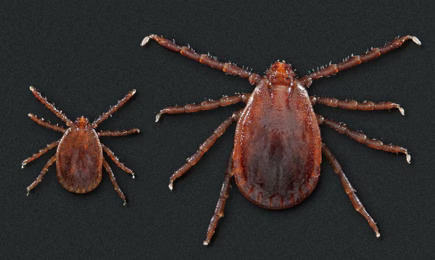Asian longhorned tick confirmed in Illinois

SPRINGFIELD, Ill. — Illinois is the 20th state to discover the Asian longhorned tick (Haemaphysalis longicornis).
The tick, considered an invasive species, was found on April 12 during routine active tick surveillance in Morgan County as part of an Illinois Department of Public Health (IDPH) grant-funded active tick surveillance program. Additional surveillance in the area on April 24 discovered two additional Asian longhorned ticks.
Identification was confirmed by entomologists at the National Veterinary Services Laboratory.
While the tick was first introduced to the U.S. in 2017, this is the first known collection of this tick species from anywhere in Illinois.
Asian longhorned ticks are light brown in color and are very small, often smaller than a sesame seed. The tick is capable of carrying tick borne diseases that affect cattle. In addition, a female can reproduce without a mate and lay up to 2,000 eggs at a time. Therefore, numbers may expand rapidly.
In a press release,Dr. Mark Ernst, Illinois Department of Agriculture (IDOA) state veterinarian, said, “In some cases of severe H. longicornis infestation, livestock death has been reported. Farmers and producers should continue working with their veterinarian to maintain an appropriate management plan.”
The IDOA, IDPH and the Illinois Department of Natural Resources (IDNR) are monitoring the situation in partnership with the United States Department of Agriculture.
“IDPH’s active tick surveillance program was instrumental in discovering the Asian long horned tick in Illinois,” said IDPH director Dr. Sameer Vohra. “Although the role that this tick will play in the transmission of infections in humans is yet to be determined, the Department of Public Health is working closing with the Department of Agriculture to monitor the presence of the tick and investigate the risk it carries to both humans and livestock.”
Tick Prevention Tips:
- Use Environmental Protection Agency (EPA)-registered insect repellents containing DEET, picaridin, IR3535, oil of lemon eucalyptus (OLE), para-menthane-diol (PMD) or 2-undecanone. Always follow product instructions.
- Treat clothing and gear with products containing 0.5 percent permethrin. Permethrin can be used to treat boots, clothing and camping gear and remain protective through several washings. Alternatively, you can buy permethrin-treated clothing and gear.
- Check your body and clothing for ticks upon return from potentially tick-infested areas, including your own backyard. Use a hand-held or full-length mirror to view all parts of your body. Place tick-infested clothes in a dryer on high heat for at least 10 minutes to kill ticks on dry clothing after you come indoors.
- Shower soon after being outdoors. Showering within two hours of coming indoors has been shown to reduce your risk of getting Lyme disease and may be effective in reducing the risk of other tickborne diseases. Showering may help wash off unattached ticks and is a good time to do a tick check.
Talk to your veterinarian about tickborne diseases in your area and prevention products for your pets and livestock.
If anyone believes they have identified H. longicornis on an animal, the tick should be placed in a jar with isopropyl alcohol, and the Department of Agriculture should be contacted at 217-782-4944.
Miss Clipping Out Stories to Save for Later?
Click the Purchase Story button below to order a print of this story. We will print it for you on matte photo paper to keep forever.

